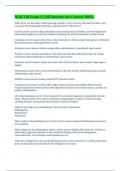NUR 310 Exam 1 || All Answers Are Correct 100%.
What all do you document while assessing wounds? correct answers Document location, size,
count any dressings/staples/steristrips, approximated or dehiscence?
Incision correct answers sharp instrument; open wound; deep or shallow; once the edges have
been sealed together as a part of treatment or healing, the incision becomes a closed wound.
Contusion correct answers blow from a blunt instrument; closed wound; skin appears ecchymotic
(bruised) because of damaged blood vessels.
Abrasion correct answers Surface scrape either unintentional or intentional; open wound
Puncture correct answers penetration of the skin and often the underlying tissues by a sharp
instrument, either intentional or unintentional; open wound
laceration correct answers tissues torn apart; often from accidents, open wound, edges appear
jagged.
Penetrating wound correct answers Penetration of the skin and the underlying tissues, usually
unintentional; open wound.
MARSI correct answers trauma related NOT pressure related
Exudate correct answers a fluid with a high content of protein and cellular debris that has
escaped from blood vessels and has been deposited in tissues or on tissue surfaces, usually as a
result of inflammation.
why does hemostasis occur? correct answers It is an initial response to losing blood and skin
injury. Blood vessels will constrict and blood clotting begins. Exudate is formed causing
swelling and pain. Increased perfusion results in heat and redness
What are the stages of wound healing? correct answers Hemostasis,
Inflammation,
Proliferation,
Maturation,
What could put the healing process at risk? correct answers Impaired inflammation processes,
poor nutrition
What happens in the inflammatory phase? correct answers Begins after injury for 3-6 days to
help bring oxygen and nutrients to the wound bed. Phagocytosis of microorganisms,
vasoconstriction, clot formation, and hemostasis occur.
What does collagen do in the wound healing process? correct answers It is a white protein that
goes into the injury site and adds tensile strength to the wound.
, How does granulation tissue appear? correct answers tissue is translucent red color, fragile
What happens in the Proliferative stage? correct answers Last next 3-24 days and replaces lost
tissue with granulation tissue and collagen, wound contraction, and wound resurfacing (new
epithelial cells).
What happens during the Maturation stage/remodeling phase? correct answers Day 21 -up to 1
year. Remodeling and strengthening of the collagen tissue occurs and fibroblasts synthesize the
collagen. Wound contracted and scar becomes stronger. The repaired area is never as strong as
original tissue
what is a hypertrophic scar? correct answers keloid; overproduction of collagen at a wound
Is wound care an independent nursing action? correct answers No; you must have provider order
and/or established protocol dictate type of cleansing agent, dressing, frequency of care, etc.
Do wounds heal differently? correct answers Type of wound healing influenced by amount of
tissue loss. Phases of healing are same for all wounds, but rate and extent of healing differ
What interventions may you need to give before you clean or dress a wound? correct answers
Pain medication/management
What is primary intention healing? correct answers Primary intention healing involves: Tissue
surfaces approximated (closed), Minimal or no scarring, Little or no tissue loss, Heals rapidly.
Example: closed surgical incision with staples or suture or liquid glue to seal laceration.
What is secondary intention healing? correct answers Secondary intention healing involves:
Extensive tissue loss, Edges cannot be approximated, Repair time is longer, Scarring is greater,
Increase risk for infection, and Heals by granulation. Ex: wet to dry dressings; pressure ulcer left
open to heal
What is Tertiary intention healing? correct answers Also known as delayed primary intention,
Initially left open 3-5 days- Edema, infection to resolve, or exudate to drain,
Closed with sutures, staples, or adhesive skin closures once edema / infection is resolved, and
Long healing time. Example: Abdominal wound initially left open until infection is resolved then
closed
What factors affect wound healing? correct answers Age- very young and very old
Impaired nutrition (especially protein!)
Lifestyle- activity, smoking, alcohol, drug use
Immunocompromise = decreased immune function
Medications
Obesity-adipose tissue is poorly perfused
Chronic diseases-anemia, diabetes, CV disease
Decreased perfusion - circulation is necessary




